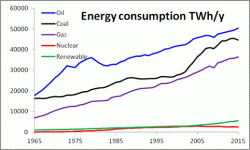repoman
Contributor
I am trying to get a handle on what is the rough multiplier effect on the heat humans release by burning fossil fuels and the total long term heat trapping just from the released CO2.
I did it a while ago on this subforum and I got that burning natural gas will be a part of trapping heat in the atmosphere that will very roughly trap the same amount of heat in about one year. However, the oceans take up much more heat than the air.
I am trying to get a rough idea as to how many tens, hundreds or thousands of liters of water the CO2 will "in effect" raise from room temp to boiling (energy wise) until the earth reaches the new set point temp all the way down to the depths of the ocean.
Just trying to get a number to make us all feel like shit. Hahaha.
Oh, you like your hot cup of natural gas heated coffee, well that will be in effect like heating the earth up by 437 cups of coffee when all is said and done as a possible example.
So basically if x(t) is all the fossil fuel energy we have released and y(t) is the heat trapped by it (from say 1750) then z(t) = y(t)/(x(t) should be increasing until it will level out.
Anyone here have a guess range for what z(t) is now and what it may be in 50, 100 or 1,000 years from now?
I did it a while ago on this subforum and I got that burning natural gas will be a part of trapping heat in the atmosphere that will very roughly trap the same amount of heat in about one year. However, the oceans take up much more heat than the air.
I am trying to get a rough idea as to how many tens, hundreds or thousands of liters of water the CO2 will "in effect" raise from room temp to boiling (energy wise) until the earth reaches the new set point temp all the way down to the depths of the ocean.
Just trying to get a number to make us all feel like shit. Hahaha.
Oh, you like your hot cup of natural gas heated coffee, well that will be in effect like heating the earth up by 437 cups of coffee when all is said and done as a possible example.
So basically if x(t) is all the fossil fuel energy we have released and y(t) is the heat trapped by it (from say 1750) then z(t) = y(t)/(x(t) should be increasing until it will level out.
Anyone here have a guess range for what z(t) is now and what it may be in 50, 100 or 1,000 years from now?

